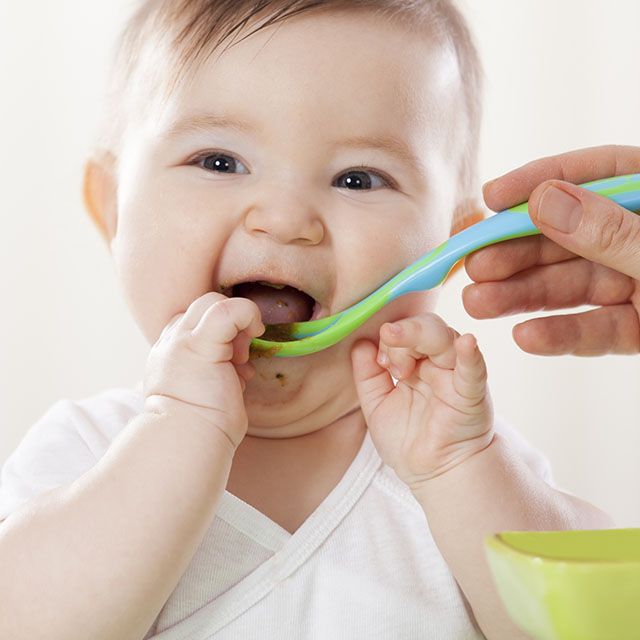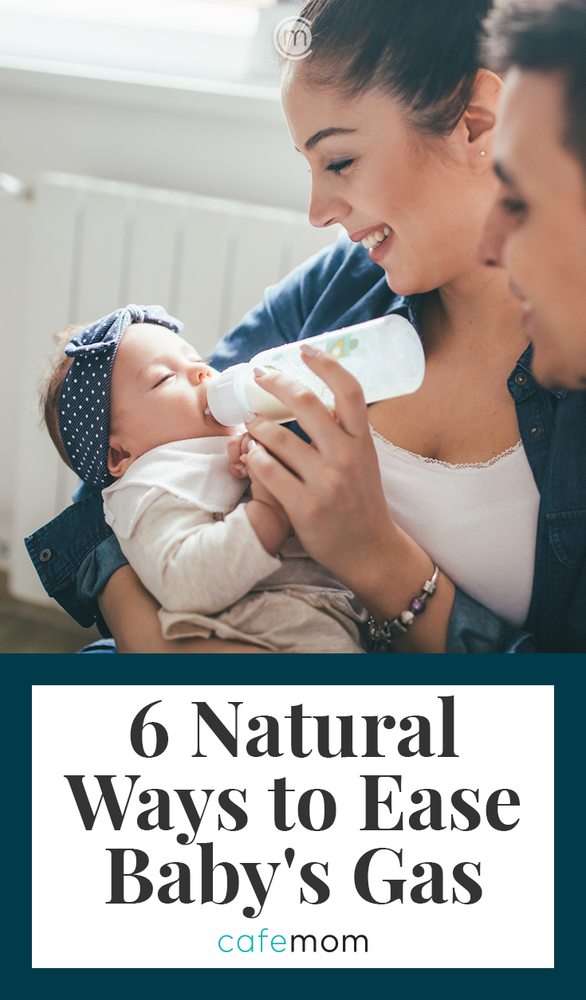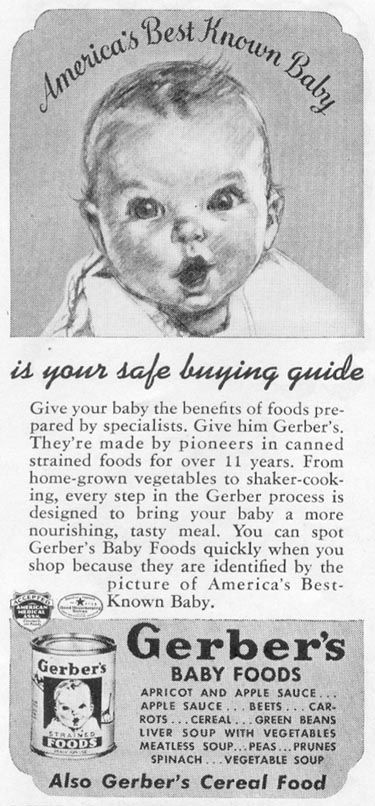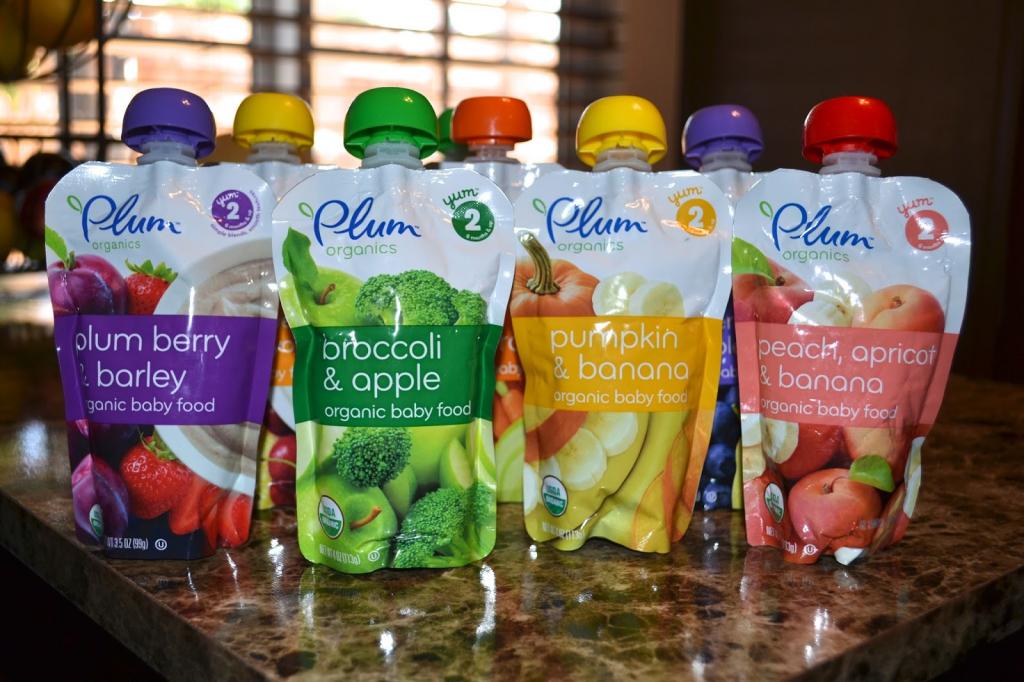Solid food portions for babies
How much should my baby eat? A guide to baby food portions
- Community
- Getting Pregnant
- Pregnancy
- Baby names
- Baby
- Toddler
- Child
- Health
- Family
- Courses
- Registry Builder
- Baby Products
Advertisement
Wondering how much to feed your baby? This can be hard to figure out, especially when you're starting solids and most of your baby's food ends up on your little one or the floor. It's also difficult to determine how much an 8-month-old (or older baby) should eat – babies this age are more interested in solid foods but still get most of their nutrition from breast milk or formula. This visual guide to baby food portions can help you figure out how much your baby should eat at every stage.
Photo credit: Karla Martin for BabyCenter
How much should my baby eat?
Do you worry that your baby is eating too little or too much? Your baby will self-regulate her food intake based on what their body needs, so let their appetite be your guide.
It's helpful to have a reference point, however. Here are photos of how much solid food a baby typically eats in a day. You can also ask your baby's doctor for feeding advice.
This visual guide shows:
- Portions for infants who are new to solids (typically 4 to 6 months)
- Two sample meals for a younger baby (6 to 8 months)
- Three sample meals and two snacks for an older baby (8 to 12 months) from a menu developed by the American Academy of Pediatrics (AAP)
Your little one may eat less or more than what's shown here. Your job is to provide a variety of healthy foods at regular intervals without pressure, and their job is to decide what and how much to eat.
Photo credit: iStock.com / UntitledImages
Watch for signs your baby is full
Lots of factors – including activity level, growth spurts or plateaus, illness, and teething – will affect your baby's appetite, which can vary daily.
End feeding when they signal that they're done. Signs of being full include:
Signs of being full include:
- Turning their head away
- Refusing to open their mouth for another bite after they've swallowed (resist the urge to encourage your baby to have one last spoonful)
- Leaning back in their chair
- Playing with the spoon or food rather than eating
Photo credit: Karla Martin for BabyCenter
How much a 4- to 6-month-old should eat
When your baby is developmentally ready for solids, typically around 4 to 6 months, talk to their doctor about introducing solid foods. The first bites are mostly about them getting used to the idea of having something different in their mouth.
- Start with a very small amount, 1 to 2 teaspoons, of a single-ingredient puree.
- Gradually increase to 1 to 2 tablespoons of food once a day.
- Follow your baby's fullness cues.
Popular first foods include pureed mango, banana, chicken, turkey, beef, peas, sweet potatoes, and infant cereal. It's up to you what food to start with, but wait 3 to 5 days between introducing each new food to make sure your baby doesn't have an allergic reaction or food intolerance. (And remember, no cow's milk or honey until age 1.)
It's up to you what food to start with, but wait 3 to 5 days between introducing each new food to make sure your baby doesn't have an allergic reaction or food intolerance. (And remember, no cow's milk or honey until age 1.)
Photo credit: Karla Martin for BabyCenter
How much a 6- to 8-month-old should eat
As your little one gets more comfortable with solids, you can increase the frequency of meals and variety of food.
- Transition from one to two meals a day, typically by 8 months.
- Over time, add a second food to each meal. The photo above is an example of a meal with two foods.
- Once you've worked up to two meals with two foods each, aim for a balance of proteins, vegetables, fruits, and grains in their daily diet.
- Whenever you introduce a new food, start with a very small amount, a teaspoon or two, to allow your baby to get used to its flavor and texture.
- Start with a soupy consistency. Gradually add more texture as their eating skills improve.

Expect their intake of breast milk or formula to go down. They'll start drinking less of it as they eat more solid foods. Provide healthy options at mealtimes, and let them choose how much to eat.
Note: The jars in all photos are standard 4-ounce baby food jars.
Photo credit: Karla Martin for BabyCenter
Breakfast for a younger baby (6 to 8 months)
Cereal and fruit make an easy combination for a morning meal.
Grain: Iron-fortified, whole-grain infant cereal is a popular first grain. At 6 months, a typical daily portion of infant cereal mixed with breast milk or formula might be 2 to 3 tablespoons, increasing to 4 to 8 tablespoons (1/4 to 1/2 cup) by 8 months. (It's best to avoid rice cereal, though.)
Fruit: Babies love the natural sweetness of fruits like pears, apples, berries, prunes, and stone fruits. Between 6 and 8 months, a baby will typically transition from about 2 to 3 tablespoons of fruit puree a day to 4 to 8 tablespoons (1/4 to 1/2 cup) of mashed or minced fruit.
Photo credit: Karla Martin for BabyCenter
Dinner for a younger baby (6 to 8 months)
If you serve a grain and fruit in the morning, consider offering a protein-rich food and vegetable later in the day. Your child may eat more or less than the amounts shown.
Protein: A baby might transition from eating 1 to 2 tablespoons of meat puree at 6 months to 2 to 4 tablespoons at 8 months, for example. Other good protein sources include cheese, unsweetened plain whole-milk yogurt, tofu, beans, and lentils.
Vegetables: Between 6 and 8 months, a baby will typically transition from about 2 to 3 tablespoons of vegetable puree a day to 4 to 8 tablespoons (1/4 to 1/2 cup). Try classic favorites like carrots, spinach, or butternut squash, as well as less traditional first foods such as parsnips, beets, or asparagus.
As your child's eating skills improve, gradually add more texture by dicing or mincing foods.
Photo credit: Karla Martin for BabyCenter
How much an 8- to 12-month-old should eat
By 8 months or so, your baby is likely getting the hang of eating and needs to eat more calories to support their growing body.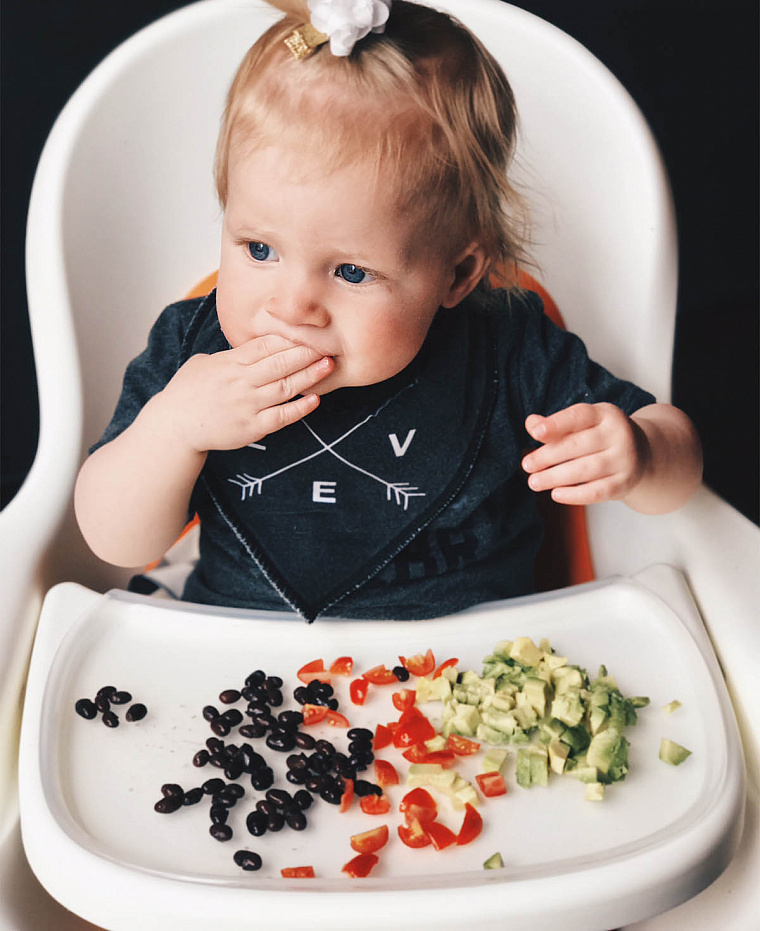 But since their little belly can't hold a lot of food, they'll need to eat more often. Every baby is different, but this may be a good time to try offering a third solid food meal.
But since their little belly can't hold a lot of food, they'll need to eat more often. Every baby is different, but this may be a good time to try offering a third solid food meal.
During this period:
- Continue to give your baby breast milk or formula.
- Add morning and afternoon snacks. (Some babies this age are happy with breast milk or formula as their snack, while others gravitate toward solid foods.) Once you've added a third meal and snacks, your baby will be eating or drinking something about every two to three hours.
- Continue to aim for a mix of proteins, vegetables, fruits, and grains.
- Introduce coarser and chunkier textures, for example, by dicing or mincing food instead of pureeing it, and graduate to soft finger foods as your baby's eating skills improve.
- Avoid foods with added sugars. Check the Nutrition Facts label on packaged foods, and try to steer clear of foods that list 1 gram or more of "Added Sugars.
 "
" - Provide healthy options, and let your baby choose how much to eat.
To visualize daily portions for an 8- to 12-month-old, check out the following photos of a typical day's menu for a baby this age, developed by the AAP.
Your child may eat more or less than these amounts. If you're concerned about how much your baby is eating, talk to their doctor for advice.
Photo credit: Karla Martin for BabyCenter
Breakfast for an older baby (8 to 12 months)
The AAP sample menu for a baby 8 to 12 months features a breakfast consisting of:
- 4 to 8 tablespoons (1/4 to 1/2 cup) whole-grain infant cereal mixed with formula or breast milk
- 4 to 8 tablespoons (1/4 to 1/2 cup) diced fruit
Note: This is an example. Your baby may eat different foods and amounts.
Photo credit: Karla Martin for BabyCenter
Morning snack for an older baby (8 to 12 months)
The AAP sample menu for a baby 8 to 12 months features a morning snack consisting of:
- 4 tablespoons (1/4 cup) diced cheese or cooked vegetables
Note: This is an example of a morning snack, which babies typically add sometime between 8 and 12 months.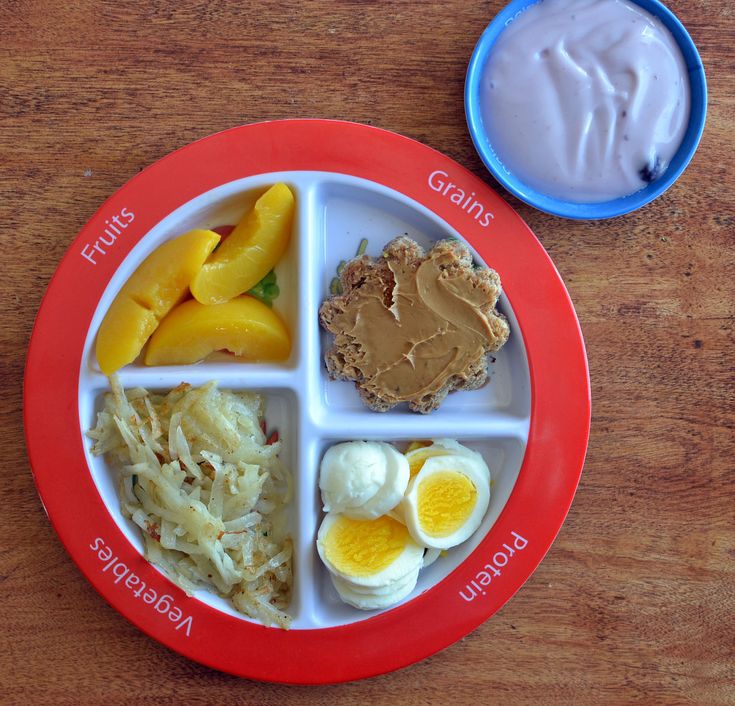 Your baby may eat different foods and amounts.
Your baby may eat different foods and amounts.
Photo credit: Karla Martin for BabyCenter
Lunch for an older baby (8 to 12 months)
The AAP sample menu for a baby 8 to 12 months features a lunch consisting of:
- 4 to 8 tablespoons (1/4 to 1/2 cup) unsweetened plain whole-milk yogurt or cottage cheese, or minced meat
- 4 to 8 tablespoons (1/4 to 1/2 cup) diced or mashed yellow or orange vegetable
Note: This is an example. Your baby may eat different foods and amounts.
Photo credit: Karla Martin for BabyCenter
Afternoon snack for an older baby (8 to 12 months)
The AAP sample menu for a baby 8 to 12 months features an afternoon snack consisting of:
- 4 tablespoons (1/4 cup) diced fruit or unsweetened plain whole-milk yogurt
- 1 whole-grain teething biscuit or cracker
Note: This is an example of an afternoon snack, which babies typically add sometime between 8 and 12 months.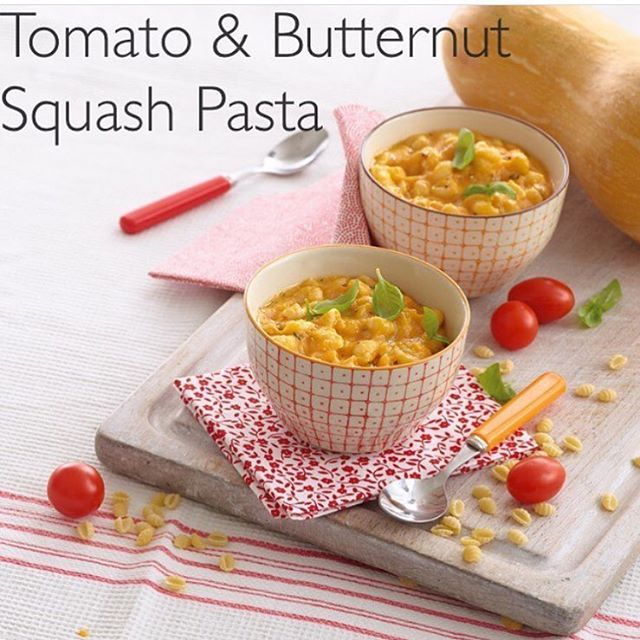 Your baby may eat different foods and amounts.
Your baby may eat different foods and amounts.
Photo credit: Karla Martin for BabyCenter
Dinner for older baby (8 to 12 months)
The AAP sample menu for a baby 8 to 12 months features a dinner consisting of:
- 4 tablespoons (1/4 cup) minced or ground poultry or meat, or diced tofu
- 4 to 8 tablespoons (1/4 to 1/2) cup diced, cooked green vegetable
- 4 tablespoons (1/4 cup) noodles, pasta, rice, or potato
- 4 tablespoons (1/4 cup) diced fruit
Note: This is an example. Your baby may eat different foods and amounts.
Photo credit: Karla Martin for BabyCenter
How much should my baby drink once they start eating solids?
Breast milk or formula will fully meet your child's hydration needs until they're about 6 months old. They may start drinking less as solid foods become a bigger part of their diet. Here are typical daily amounts by age – your baby's intake may be different, however.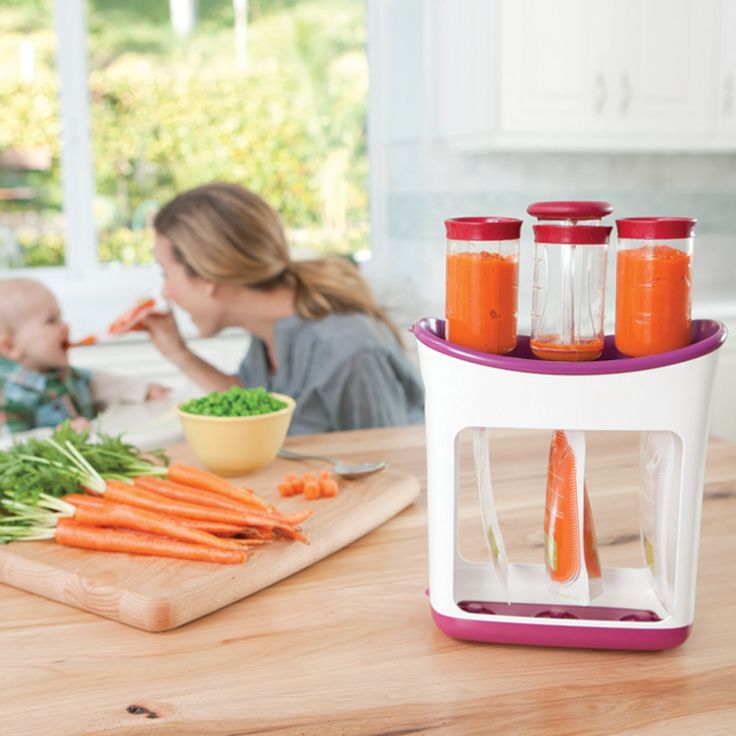
6 to 8 months: 24 to 32 ounces of formula, or continued breastfeeding on demand
8 to 12 months: 24 ounces of formula, or continued breastfeeding on demand
Water: You can offer your baby water once they start eating solids, but let them self-regulate how much they drink. The Centers for Disease Control and Prevention (CDC) recommends giving babies who are 6 to 12 months old 4 to 6 ounces of water a day, but what your baby decides to drink may vary. They may drink more on a hot day, for example.
Avoid juice: Juice isn't recommended for babies younger than 12 months.
Photo credit: iStock.com / SDI Productions
Your baby has the final say
Keep in mind that these portions are an estimate. The truth is, every baby is different, and there's no set amount of food that's appropriate for every baby at every stage.
If you're worried about whether your baby is eating enough – or too much – the best advice is to look for and respond to signs that your baby is full.
Your baby's doctor will chart their weight gain at regular intervals. If the doctor sees a consistent growth curve and doesn't have other concerns, your baby is most likely eating the right amount of food.
Hungry for more?
Age-by-age guide to feeding your baby
The 10 best foods for babies
The worst foods for babies
Using spices and seasoning in baby food
Elizabeth Dougherty
Elizabeth Dougherty is a veteran parenting writer and editor who's been contributing to BabyCenter since 2015. She's an intrepid traveler, devoted yogi, and longtime resident of Silicon Valley, where she lives with her husband and son.
How Much Should I Feed My Baby?
Learn about the importance of starting solids and how much your baby will eat through the process.
One of the most common questions parents have about nutrition in the first year of their baby’s life is “How much should I feed my baby?“
Especially when it’s time to start babies on solid food.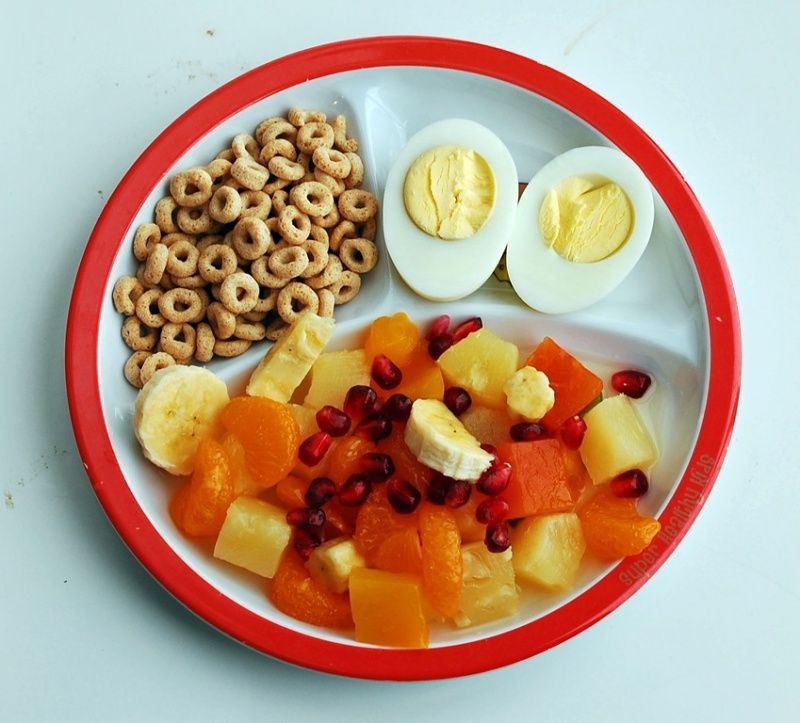
Your baby’s eating varies in the first year of life.
He’ll start with very small amounts of food at the beginning of solid food introduction, around 6 months.
But, by a year of age, your baby should be eating mostly family food, served in developmentally-appropriate textures and food portions.
So how do you get there?
First, you need to understand that how much your baby eats will depend on two things: His appetite and how old he is.
Older babies eat more food than younger babies.
If you’re just starting solids with your baby, read on to learn about the appropriate food portion sizes for baby, as well as how to watch for appetite signals that indicate your baby wants more food, or wants to stop eating.
You Will Learn:
- Your baby’s unique nutritional needs
- How much to feed your baby
- Your baby’s appetite cues
- How to focus on promoting self-regulation with eating
- What a typical day of eating looks like for a 6 to 10 month old looks like
It’s always a surprise for parents to hear that babies have higher caloric requirements per pound of body weight compared to toddlers and older children.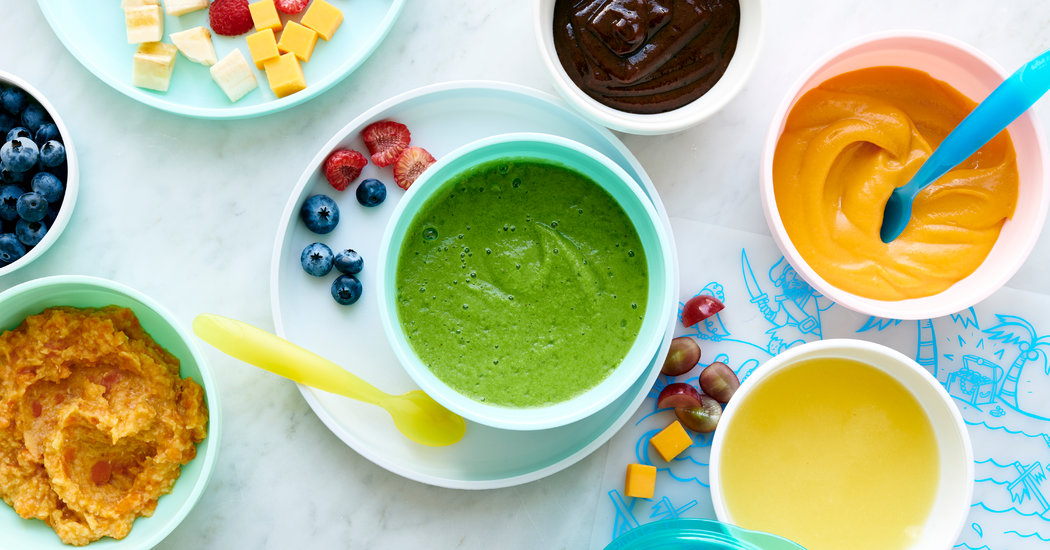
Most young infants between 0 to 6 months need about 100-120 calories/kg/day, and by one year, around 95-100 calories/kg/day.
After calories, nutrients are very important to the growth and development of your baby.
Especially, fat, essential fatty acids like DHA, vitamin D and calcium, and iron.
They all play important roles in ensuring the proper development of your baby’s brain, body, and bones.
How Much Should My Baby Eat?No baby eats the same amount as another baby.
There’s quite a bit of individuality.
How much food your baby should eat isn’t really the question to be asking.
Rather, you should be focused on your baby’s appetite signals and preserving his inherent ability to know how much to eat.
Thankfully, babies are very skilled at regulating their food consumption, something called self-regulation.
As you can see, during the transition from 6 months to a year, food becomes a bigger contributor to covering your baby’s energy and nutrient needs for growth and development.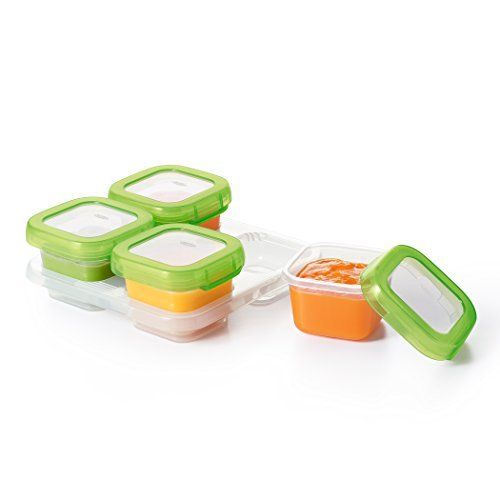
[If your baby refuses to eat, this can indicate illness or other medical issues. Check with your doctor.]
[Read: Baby Changes and Eating: What to Expect]
How Much Should My 6 Month Old Eat?Despite having high calorie needs, babies don’t actually need to eat as much food as you might think.
In the first 6 months, all of your baby’s food requirements should come from breastmilk or infant formula.
At 6 months, most babies will start to eat solid foods.
Though, the amount of real food eaten will be very small.
How much puree for your 6 month old?
A tablespoon or two once or twice a day is pretty typical.
(Keep reading for a sample eating plan for 6-8 month and 8-10 month old babies.)
Here are suggested amounts of food per day for a 6 month old baby, as per the American Academy of Pediatrics (AAP):
- 1 – 2 ounces of Grains
- 1 -2 ounces of protein
- 2 – 4 ounces of vegetables
- 2 – 4 ounces of fruit
The purpose of this early stage of baby feeding is simply to introduce flavors and textures to your baby.
It’s also designed to get him used to the prospect of eating from a spoon or self-feeding.
Using a Baby-Led Weaning Approach?If you are starting with the baby-led weaning (BLW) approach, you’ll skip the spoon and offer whole foods cut into finger-like shapes, while making sure the foods you offer can easily melt or be mashed in your baby’s mouth.
Since there’s not a lot of actual food consumed in the early stages of BLW, you’ll want to make sure you offer nutrient-rich foods, particularly high in iron, fat, and omega-3 fatty acids like DHA.
Read more about Getting Enough Iron and Baby Led Weaning.
You can also do a mixed approach: combining traditional spoon-feeding and baby-led weaning to get the best of both options.
I cover this in depth in the podcast episode, Starting Baby on Solids, Flexibly.
How Much Should My 8 Month Old Eat?By the time your baby is 8 months old, he will have already tasted lots of new flavors and textures.
He should also be interested in feeding himself, and advancing to chopped foods (no more purees as a staple in the diet!).
At this age, it’s typical for him to eat three meals a day of real food, modified in texture to meet his developmental eating skills.
Portion Size for an 8 Month Old
The following are target amounts outlined in my book, Fearless Feeding:
- 2 – 4 ounces of grains
- 2 – 4 ounces of protein-based foods
- 4 – 6 ounces of vegetables
- 4 – 6 ounces of fruit
Because your baby’s body is growing so much in the first year, amounts of food are small at first, but once your baby gets the hang of eating real food, his eating amounts will increase, and breastmilk intake (or formula) will decrease.
How much should I feed my baby? Click To Tweet
Remarkably, even before your baby can talk, he is able to give physical signs that indicate he is still hungry or that he is done eating, such as crying or turning his head away.
| Your Baby May be Hungry if… | Your Baby May be Full if… |
| He fusses or cries.
| He decreases the rate of sucking or stops sucking. |
| She smiles, gazes or coos at you during a feeding. | She spits out the nipple.
|
| She moves her head toward the spoon or bottle.
| She becomes easily distracted or pays more attention to the environment around her. |
| He reaches for or points to food. | He moves his head away from food. |
| Your baby shows excitement when food is offered. | Your baby slows the pace of eating.
|
| She uses sounds, words or signs to indicate hunger. | She cries or shakes her head “no.” |
Your baby’s hunger and fullness cues indicate appetite and are an essential part of the feeding process.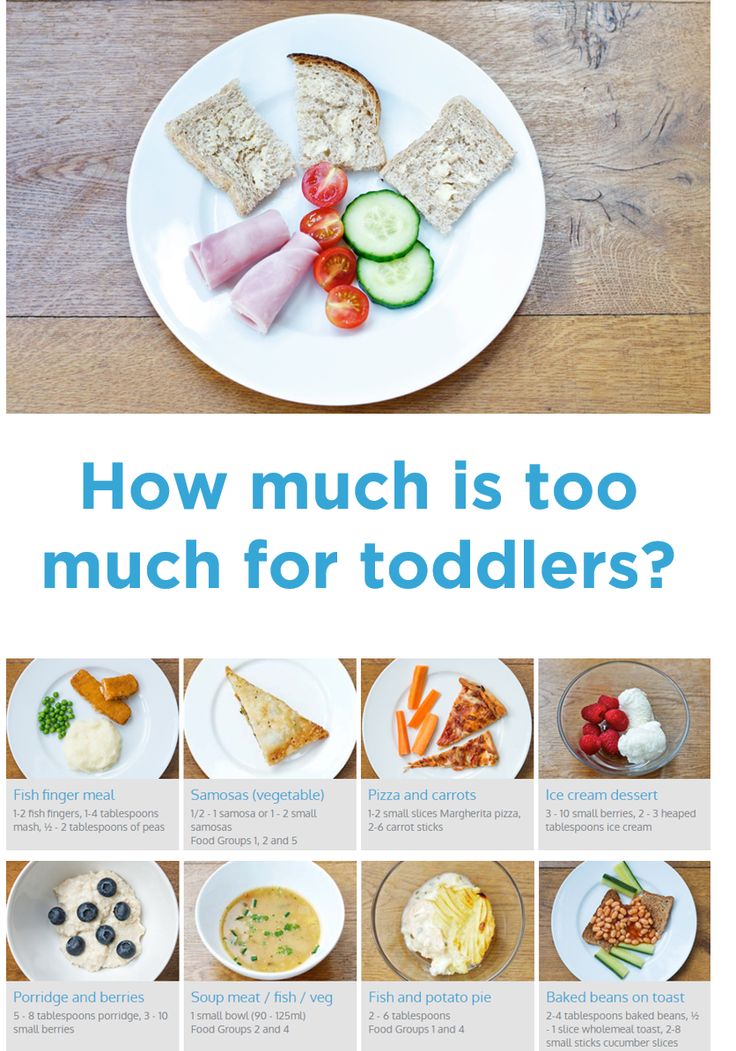
If you delay your baby’s meal because it isn’t “time to eat” yet, you may be ignoring a growth spurt and the natural increase of hunger that accompanies it.
Trying to feed your child more when she is signaling to you she’s done has the potential to interfere with this natural ability to self-regulate food consumption.
This is called forcing or pressure to eat.
Portion Sizes for Baby and Honoring Appetite CuesIf you want to know portion sizes for a 10 month old and beyond, you can work from the 8 month old portions and start with a small amount of food initially, and pay attention to your baby’s appetite cues.
Generally, begin with a tablespoon or two of food.
As your baby grows, you may start with larger amounts.
Appetite cues are the most important indicators for offering more food or stopping the feeding session.
Small portions are a good guideline of how much food to give to your baby, they aren’t a definitive meal plan, per se.
Follow your baby’s appetite signs.
They will govern the ultimate amount of food he or she eats at mealtime.
[Read more about Starter Portions.]
[Watch my video about Toxins in Baby Food!]
Baby Feeding Chart: Sample Day of EatingThe baby feeding chart below summarizes how much food from each food group you might offer your baby throughout the day.
(For toddlers and older children, see the difference in recommendations for portion sizes.)
Note: The emphasis of this chart is on what a day could look like in terms of food.
Every baby is different, and each family will proceed with baby food reflecting their food preferences, feeding approach and cultural values.
All babies should be consuming either breastmilk or formula throughout the first year of life.
Sample Day of Eating for a 6-8 Month Old Baby| Morning | Breast Milk or infant formula |
| Breakfast | 2 to 4 tablespoons of iron-fortified cereal mixed with breast milk or formula 2 to 3 tablespoons fruit or vegetable 1 egg yolk mashed with breast milk or formula |
| Midmorning | Breast milk or infant formula |
| Lunch | Breast milk or infant formula |
| Late Afternoon | 1 to 4 tablespoons of iron-fortified cereal mixed with breast milk or formula 2 to 3 tablespoons fruit or vegetable 1/2 cup plain yogurt |
| Dinner | Breast milk or formula 2 to 3 tablespoons of meat or meat alternative 2 tablespoons of cereal or 1/2 slice of bread (8 months) 2 to 3 tablespoons fruit or vegetable |
| Before Bed | breast milk or infant formula |
Sample Day of Eating for an 8-12 Month Old Baby
| Morning | Breast milk or infant formula |
| Breakfast | 4 to 6 tablespoons iron-fortified cereal mixed with breast milk or infant formula 2 to 4 tablespoons of fruit or vegetable 1 egg yolk mashed with breast milk or formula |
| Midmorning | Breast milk or infant formula |
| Lunch | Breast milk or infant formula 2 to 4 tablespoons meat or meat alternative 3 to 4 tablespoons of pasta 2 to 4 tablespoons fruit or vegetable |
| Late Afternoon | 2 to 4 tablespoons fruit 1/2 cup plain yogurt |
| Dinner | Breast milk or infant formula 2 to 4 tablespoons of meat or meat alternative 2 crackers 2 to 4 tablespoons of vegetable |
| Before Bed | Breast milk or formula |
*According to the AAP, from 8-12 months, your baby will need about 750-900 calories per day, and 400-500 calories should come from breast milk or formula (about 24oz or 720ml a day).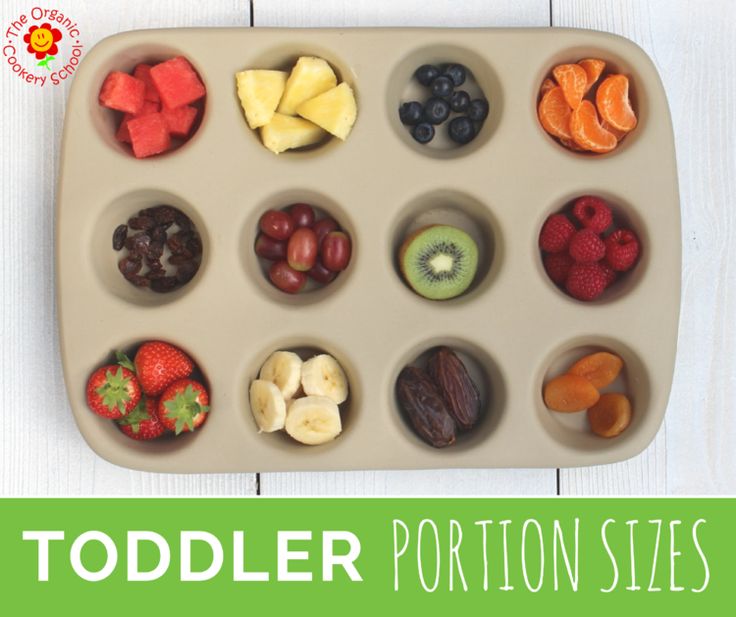
If you buy baby food or make your own, use these conversions to help you figure out how much you need:
2.5 oz = 5 tbsp
4 oz = 8 tbsp
6 oz = 12 tbsp
How Much Should You Feed Your Baby, Step by Step- When starting out, offer your child an appropriate starter portion based on his age from most food groups. Try to give him a balanced representation of what’s on the menu for the meal.
- Let your child enjoy eating and watch for his appetite signals. If he’s still hungry, offer more food. If he’s showing signs of fullness, end the meal.
- Be flexible. Sometimes your baby will want to eat more or less than she is “supposed to eat,” but that doesn’t necessarily mean you need to worry.
Your baby’s hunger and appetite will generally depend on his size, activity level, and stage of growth. When babies are in a growth spurt, they typically are hungrier.
Most importantly, remember that every baby is different.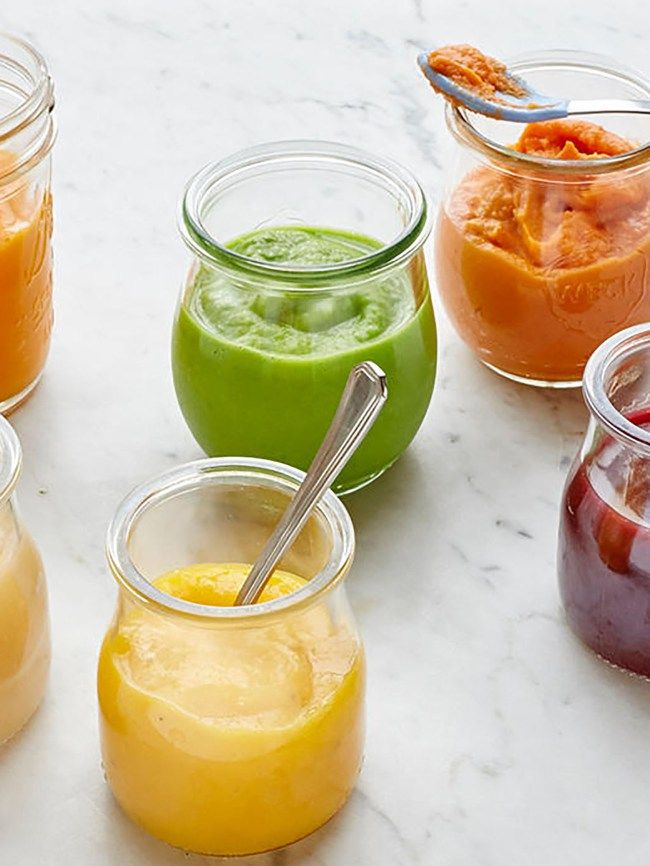
And every day can be different!
Babies are good at figuring out how much to eat and when to stop, provided you respond appropriately to feeding and appetite cues.
Frequently Asked QuestionsThere are always more questions! I’ve tried to answer the most common ones I hear.
If you have another question, post it in the comments below and I’ll try to answer!
What if my baby doesn’t eat all the food I’ve made for her?Don’t worry. Trust that your baby is able to understand her body’s appetite signals that tell her how much to eat.
Don’t ever force your baby to finish a meal or bottle.
What if my baby is still hungry after I’ve fed her enough food for the day?Your baby may be in a growth spurt, which means energy needs are higher. This can show up as a greater appetite than normal.
Again, don’t worry! He may just be letting you know he’s growing and needs to eat a bit more.
Babies eat every two to three hours throughout the day and night.
As they grow, their tummies can hold more food, so they may be able to last three hours between eating sessions, but this will vary based on the individual child.
What foods should I avoid giving to my baby?Honey or corn syrup are no-no’s in the first year of life due to the risk of botulism poisoning.
No cow’s milk until one year of age, however, milk baked in food products (e.g., a muffin), and plain yogurt at 6 months is okay.
Avoid sweets as much as possible.
Can my baby eat peanut butter?Yes! Read When Can I Give my Baby Peanut Butter and How to Introduce Peanuts to Your Baby for more information.
Need More Help with Baby Feeding?I wrote a complete guide to starting solids to help you navigate nutrition, food amounts, baby led weaning, food allergy prevention and more.
No fluff.
Just straight-forward guidelines to keep you on track during this rapidly changing phase of feeding.
Check out my book, The Smart Mom’s Guide to Starting Solids.
Grab your copy today!
References:
Feeding Guide from the Women Infants and Children (WIC) program.
Check out this site for more information on portion sizes for your 1-4 year old child.
When Can Babies EAT REAL FOOD? | 5 Signs that Tell You When You Can Start Solids
Watch this video on YouTube
Originally published in February 2018 | Updated September 2020
How much food should a child eat? What is a serving or serving size for a child? - Encyclopedia Baby food
Levchuk Victoria©
Moms often ask these questions, don't they? Most pediatricians will say, "Feed your baby as much as he can eat."
When a baby is introduced to complementary foods, make sure he is still getting the right amount of formula and/or mother's milk. Solid foods at an early stage are meant to be practiced. Complementary foods are not intended to provide complete nutrition to the baby like formula and/or breast milk.
Solid foods at an early stage are meant to be practiced. Complementary foods are not intended to provide complete nutrition to the baby like formula and/or breast milk.
Contents:
How much solid food a child should eat depends on many different things.
It should not be forgotten that the child is a human being and, like all of us, he has his own appetite. This affects how much complementary foods he will eat. As with adults, some babies eat more than others due to their individual appetite. Below are some of the main points that are important to remember when feeding your baby.
- A baby who was introduced to solid foods at four months of age is likely to eat more solid foods than a baby who first tried food at six months of age.
- A child who eats soft cut foods eats less than a child who is fed pureed foods.
- A child who is sick or teething may eat less than a few days ago, and then suddenly develops an atypical appetite.
- A child who is busy studying a carpet or a new book may not be interested in food at the moment.
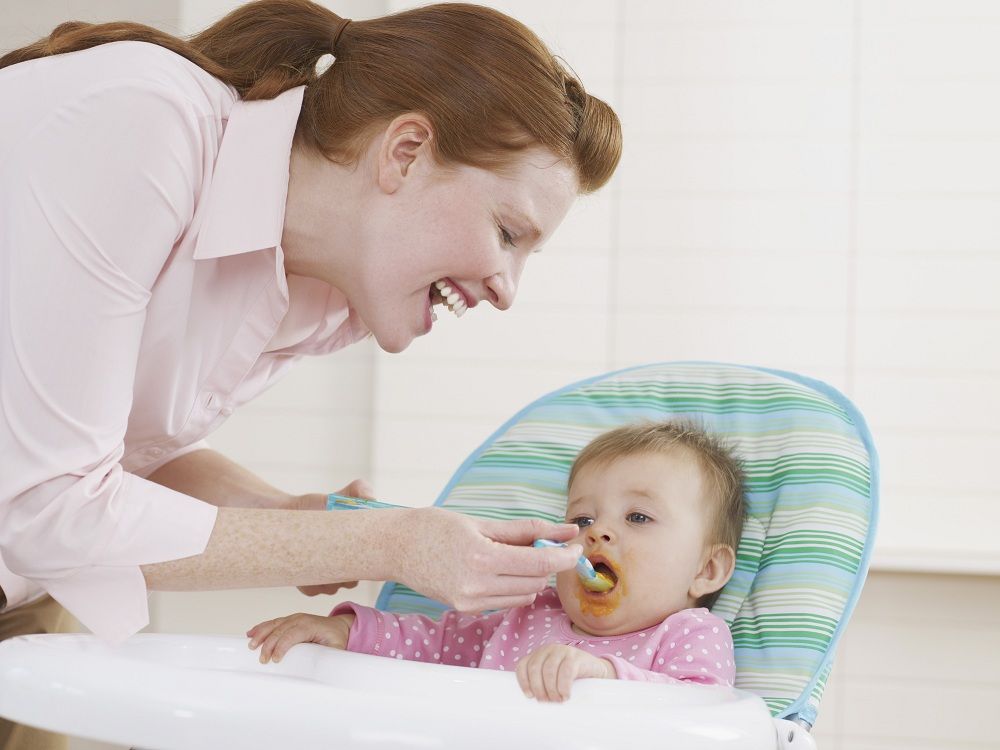
- Naturally, growth retardation in infants also affects appetite. It can be brutal for weeks or days, and then all of a sudden, the child refuses to eat. Children who experience frequent growth spurts will tend to reduce their food intake during growth retardation.
How does a mother know if a child is eating enough adult food?
All pediatricians will say: "A child will never go hungry!" A huge number of healthy children will eat the right amount of food that they need. Parents need to fight the urge to offer "just one more bite" when a child shows they're done. After all, you don’t want to accidentally disrupt the child’s developing ability to self-regulate their feeding by continuing to try to feed or feed the child. It is important for parents to pay attention to the baby's signals, as the baby's feeding patterns will change daily and can be affected by the activities around him. By offering a good balanced diet, you can ensure that your child is eating the right amount of nutrients.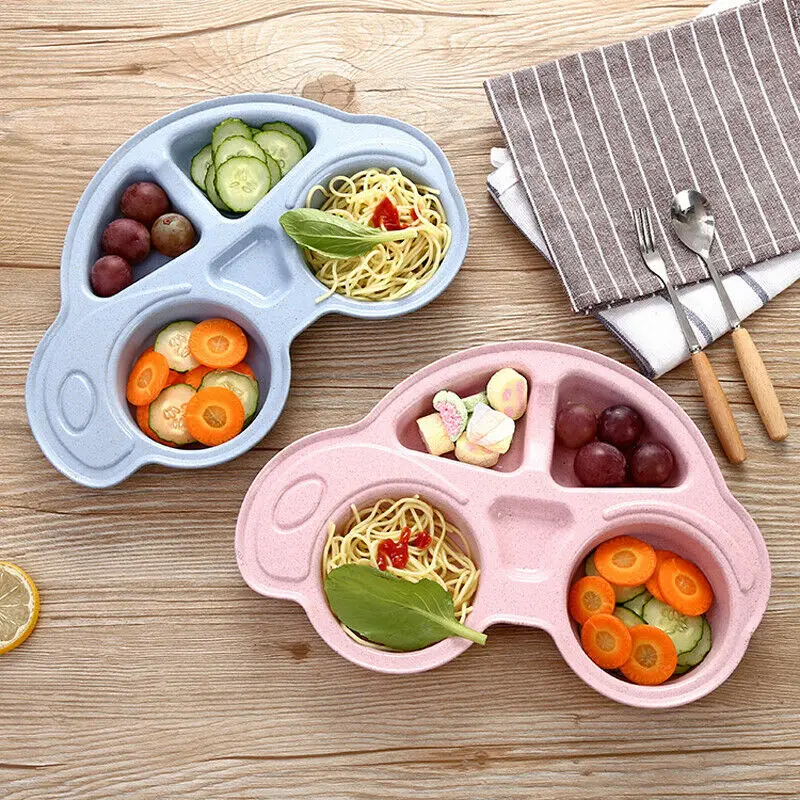
Feeding example
Babies should be able to sit up on their own and spoon feed before introducing complementary foods.
Why can't a mother introduce complementary foods to a child under 4 months of age? Introducing solid foods too early means that the baby receives less breast milk during infancy, and this reduces the chance of receiving the optimal benefits of protection against infection.
What to feed the baby:
Formula milk or mother's milk every 1-3 hours, formula milk 500-1200 grams per day seems hungry after the main breastfeeding, the baby is ready for the introduction of complementary foods! The child should be able to hold his head well, close his mouth with a spoon, and move food towards the back of his mouth. You can read all the signs of readiness for weaning here.
How to feed a child:
Dairy Milk or mother's milk
1-3 tablespoons of food for 1 or 2 dishes
-
6-8 months:
Dairy mixture and / or maternal milk still the main food at this age.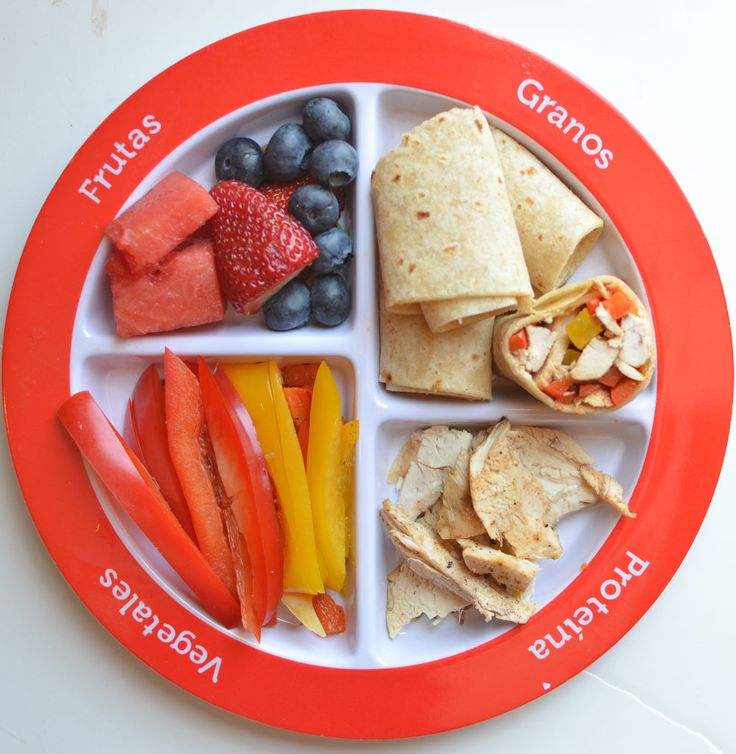 Babies in this period are just starting solid foods, so the diet tried at 4-6 months of age will also apply. Some children can eat up to 230 grams of solid food 2-3 times a day.
Babies in this period are just starting solid foods, so the diet tried at 4-6 months of age will also apply. Some children can eat up to 230 grams of solid food 2-3 times a day.
What to feed the baby:
Formula milk or mother's milk
Complementary foods 2-3 times a day.
-
8-10 months:
Many babies will eat 3 meals a day at this stage; including cereals, fruits, vegetarian dishes, breads and meats, maybe eggs.
It is important for parents to pay attention to the baby's signals, as the baby's feeding patterns will change daily and may be affected by the activities around him. The child will eat only the right amount of food for himself.
How to feed a child:
Dairy mixture or maternal milk
Power feeding 3 times a day
-
10-12 months:
Many children will eat 3 times a day at this stage; including cereals, fruits, vegetarian dishes, bread, meat, fish, eggs.
It is important for parents to pay attention to the baby's signals, as the baby's feeding patterns will change daily and may be affected by the activities around him. The child will eat only the right amount of food for himself.
How to feed a child:
Dairy mixture or maternal milk
PRODUCT 3 times a day plus 2 additional snacks
Signs that the child wants to eat:
- leans behind a spoon
- Opening his mouth
- Grabs food and tries to put it in the mouth
Signs that the baby is full
- Closing the mouth when a spoon approaches it
- Spitting out food while feeding
- Turning the head to the side when the spoon approaches
A healthy, well-fed baby should wet diapers regularly and also have bowel movements once or twice a day.
When visiting a doctor, it is necessary to make sure that the child is healthy in order to properly monitor the child's height and weight according to the schedule.
If there is any doubt about feeding the baby, the pediatrician should be consulted about the foods and amounts of solid food. The doctor should be able to help arrange feedings as well as help allay concerns.
It is important to remember to consult with your pediatrician regarding the introduction of complementary foods for your baby and to specifically discuss any foods that may pose an allergy risk to your baby.
There are no two identical children who will eat the same foods. And the amount of food for each child individually!
To calculate your daily milk intake, you can use the following:
All of the baby's signals during feeding tell him that the baby is eating the right amount of food for him.
There is no exact rule or guideline for how much a child should eat during the day. Simply because every child is different. Babies will eat and drink as much formula or mother's milk as they need.
For example, one 7-month-old baby eats 2 whole jars of baby food in one day while another 7-month-old baby barely manages to eat one. Also, one child can eat every 2 hours in his 7 months, and the other every 3-4 hours. Again, each child has different nutritional and milk needs and these needs are tailored to the individual.
Solid food | Tervisliku toitumise informatsioon
From the age of 6 months, in addition to breast milk, the baby needs to be supplemented to provide the necessary amount of energy and nutrients. As you grow older, you can gradually switch to regular food (cooking it without frying, and also without adding salt and sugar). Children over 1 year of age, in addition to regular food and complementary foods, can continue to drink breast milk, but by the age of two, the child should completely switch to a common table. Exposure of a child to grain-containing foods during breastfeeding may protect him from gluten intolerance in the future. When offering a child complementary foods or regular food, care should be taken, so that the food is varied . Both during breastfeeding and during the transition to regular food, the baby may experience gases or allergies .
When offering a child complementary foods or regular food, care should be taken, so that the food is varied . Both during breastfeeding and during the transition to regular food, the baby may experience gases or allergies .
For children over 2 years of age, the same nutritional guidelines apply as for adults, but the recommended serving sizes are smaller.
Children under three years of age (actually, a person of any age) do not need salty or sweet snacks, carbonated drinks, deep fried and/or very sweet and salty foods!
By the sixth month of life, the infant's eating habits and digestive system are mature enough to offer more solid foods in addition to breast milk. Proteins, carbohydrates and fats contained in regular food are different from the easily digestible sugars, fats and proteins that enter the baby's body with breast milk. Therefore, a so-called certain familiarization period is needed so that the baby's digestive system has time to get used to a new type of food.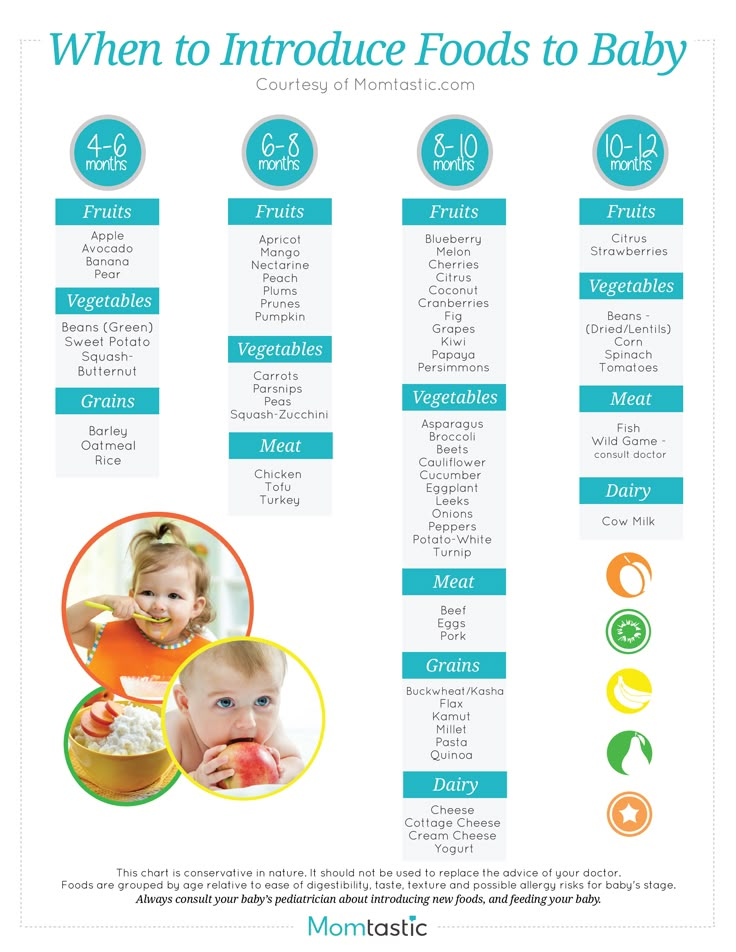 If the baby is breastfed as often as before, then these feeds cover about 2/3 of the energy needed by an 8-month-old baby. The remaining approximately 200 kilocalories should come from the various macronutrients found in complementary food ingredients, i.e. proteins, fats and carbohydrates. Complementary foods are needed so that the child can slowly move to the common table, as well as to obtain the nutrients necessary for age. Complementary foods for babies are a completely unfamiliar thing. It differs significantly from breast milk and will take time to learn how to eat it.
If the baby is breastfed as often as before, then these feeds cover about 2/3 of the energy needed by an 8-month-old baby. The remaining approximately 200 kilocalories should come from the various macronutrients found in complementary food ingredients, i.e. proteins, fats and carbohydrates. Complementary foods are needed so that the child can slowly move to the common table, as well as to obtain the nutrients necessary for age. Complementary foods for babies are a completely unfamiliar thing. It differs significantly from breast milk and will take time to learn how to eat it.
Proper complementary foods are food that is hard enough to eat with a spoon, contains all the important foods (except sweets), is rich in nutrients and does not contain salt or sugar. Complementary foods should always be offered to the child from a spoon and never from a bottle, as in this case the child will never understand what to eat in an upright position using a spoon. In addition, bottle feeding contains too much water, so it may not provide enough energy and nutrients.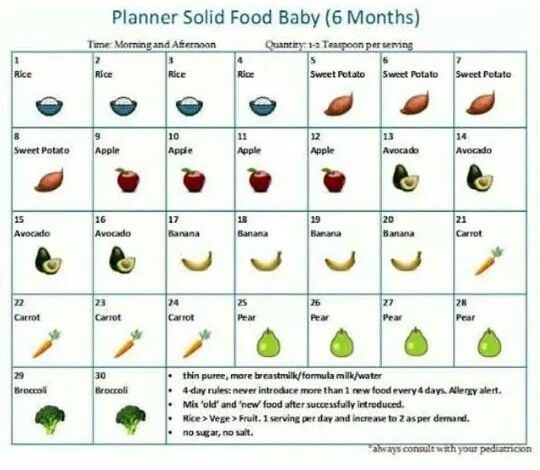 As the child grows older, you can allow him to put pieces of food in his mouth with his fingers. Simultaneously with the gradual introduction of solid food into the baby's diet, his interest in breast milk gradually begins to fade. This is completely natural and as the first birthday approaches, you can start to slowly reduce the number of breastfeeds. All children are different, so their preferences and needs are also different, but it is important that the child's diet is varied and covers all the nutritional needs of a growing body for life and development.
As the child grows older, you can allow him to put pieces of food in his mouth with his fingers. Simultaneously with the gradual introduction of solid food into the baby's diet, his interest in breast milk gradually begins to fade. This is completely natural and as the first birthday approaches, you can start to slowly reduce the number of breastfeeds. All children are different, so their preferences and needs are also different, but it is important that the child's diet is varied and covers all the nutritional needs of a growing body for life and development.
Complementary foods for infants by month:
0-6 months
6-8 months
9-11 months
substances can be markedly reduced.
World Health Organization recommendations for the introduction of complementary foods for children aged 6-23 months.
| Age (in months) | Frequency Frequency | The portion for 1 feeding | Power consistency |
| 6 | 9000 or 2 times a day | 9000 9000) quantity Finely pounded or pureed | |
| 6-8 | 2-3 meals a day
| ||
| Trucrated or pureed | |||
| 9-11 | 3-4 feeding per day 1-2 Open 1-2 | Crowned or finely busy | |
| 12-2-23 | 3-4 feeding per day 1-2 snacks | 9000 2-2. |





